One thing I love about the outdoor community is the shared value of responsibility in sustainability and conservation. If you like to spend quite some time outdoors, you’ll definitely have heard of or read the mantras: “Take out what you bring in” or “Leave no trace”. Leave-no-trace camping is becoming a necessary approach to travel in the wild. This whole pack-in pack-out principle emphasizes a zero-waste methodology for exploring the wilderness, with the goal for the camper or hiker to have as little impact as possible on the land they’re visiting. Simply, it’s the best practice we should follow to enjoy and protect our natural spaces.

The principle of ‘leave no trace’ started in response to the increase of foot traffic in wilderness areas and the concern of harming the natural species and land in that area. Approximately 16.83 million people visited a national park in Canada during the fiscal year 2017/18 compared to the 12.55 million in 2010/11 (34.1% increase between those two data points).
 While you, as a single hiker or camper, might not have a significant impact, the cumulative effect of thousands of outdoor-loving visitors over the last few decades will start to have its consequences.
While you, as a single hiker or camper, might not have a significant impact, the cumulative effect of thousands of outdoor-loving visitors over the last few decades will start to have its consequences.
I’ve noticed that when I do any outdoor activity, I’m suddenly 50 times more conscious about my actions, such as the way I dispose of my food or what I might be stepping on; I’m literally THE sustainable angel when it comes to having to go outdoors. But it’s a shame it doesn’t translate to my everyday activities in the city – now that’s a discussion for another time (Are you the same though? Why?). While most of us don’t intend to harm our environment, many do lack the knowledge of how to preserve it. So here are a few tips I’ve picked up along the way from friends and family, as well as online, from outdoor co-op REI to The Mountaineers’ 10 Essential Systems.
7 Leave No Trace Principle
1. Plan ahead and prepare.
-
 Get a map, compass and most importantly, a headlamp.
Get a map, compass and most importantly, a headlamp.- Prep for extreme weather and emergencies
- Make sure you’ve got that booking down (if need be)
- Bring toilet paper
2. Travel and camp on durable surfaces.
-
- Camp at least around 200 feet from lakes and streams
- Camp where vegetation might be absent
- Always stay on trail
3. Dispose of waste properly.
-
- Bring a bag to put all your finished food and trash in
- PACK IT IN, PACK IT OUT
- If you gotta poop, dig a hole at least 6 inches deep and at least 200 feet from water, camp and trails. Cover and disguise the hole when done.
4. Leave what you find.
-
- Just check them out; let the rocks, plants, all natural objects, and artifacts be.
5. Minimize campfire impacts (be careful with fire).

6. Respect wildlife.
-
- Don’t approach them excitedly. Limit your noise if you want a closer look.
- Never feed the wildlife.
7. Be considerate of other visitors.
-
- A nice “hello!” and a smile goes a mile when you’re out in the wild
One thing I’ve done (and many others might be familiar with) to reuse my resources and try to produce as little waste as possible is drinking the water I used to wash my dishes.
 Clean water can sometimes become a scarce asset when you’re deep within the wilderness. After washing or rinsing my cooking pot with my scarce clean water, I drink it. Yes, it might taste of mac and cheese but it’s water and I need water.
Clean water can sometimes become a scarce asset when you’re deep within the wilderness. After washing or rinsing my cooking pot with my scarce clean water, I drink it. Yes, it might taste of mac and cheese but it’s water and I need water.
Another thing is, while packing to go out, instead of bringing granola bars in their mostly plastic packaging, I like to unwrap my bars and put them in my fabric pouch to-go. Although I’m still producing plastic waste, I’m throwing my trash out at home instead of fussing about making space to put my plastic trash. It just skips the step of worrying about plastic flying out of my hands or stuffing it somewhere or forgetting about it.
Anyway, going outdoors sometime soon? Here’s a nice list of 10 essential systems (thanks REI) you should consider when packing (depending on your activity of course):
- Navigation: map, compass, altimeter, GPS device, personal locator beacon (PLB) or satellite messenger
- Headlamp: plus extra batteries
- Sun protection: sunglasses, sun-protective clothes and sunscreen
- First aid: including foot care and insect repellent (as needed)
- Knife: plus a gear repair kit
- Fire: matches, lighter, tinder and/or stove
- Shelter: carried at all times (can be a light emergency bivy)
- Extra food: Beyond the minimum expectation
- Extra water: Beyond the minimum expectation
- Extra clothes: Beyond the minimum expectation
However, at the end of the day when we come back to the city, we’re just back to constantly consuming and disposing. Is the way I act when I’m outdoors all just a mindset thing? How do I carry my outdoor mindset to my daily lifestyle?

Sources:
https://www.rei.com/learn/expert-advice/leave-no-trace.html
https://www.rei.com/learn/expert-advice/ten-essentials.html
https://wikitravel.org/en/Leave-no-trace_camping
https://www.statista.com/statistics/501269/national-park-visitors-in-canada/

Really great post! You brought up a bunch of excellent points that more people, especially Vancouverites, need to think about before they take on that new trail. One thing I would have liked to hear more about is what you recommend for emergency contact. Specifically, what do you do with your phone when you go out to be ready for the unexpected? Obviously keep it fully charged before leaving, but do you bring a power bar? Turn off your phone? Not take your phone since it won’t work in most hiking places? But really great points and cool photos! I would love to hear more about the insights you have from your hiking experience.
Hey Rachel!
I absolutely loved seeing all of the photos of the amazing adventures that you’ve been on! As an avid camper and outdoors person, I am fully aware of the “pack it in, pack it out” mantra. It frustrates me so much when I see people littering and not respecting the environment, that I always make an effort to do my part in cleaning up public spaces. One thing that has been a life saver for me while on my own adventures has been the life straw. If i’m ever low on water and there’s a suspicious body of water, I am always 100% confident when drinking the water out of my life straw. For those that have not heard of it, here’s some additional information: https://www.lifestraw.com/ . Look forward to following more of your adventures, happy camping!
– Kevin 🙂
This was a great read. You’re so right – I find whenever I go hiking or camping, I’m much more aware of my environmental impact than in my day-to-day. I think this stems from the connection we feel whilst in nature. The cumulative effect you touched on is absolutely key in creating change. While often individuals feel their efforts are negligible, what’s important to focus on is if everyone does their part, the collective impact is significant.
Further, your specific recommendations and tips for being environmentally conscious are super helpful! I’ll definitely come back to this post this summer. 🙂